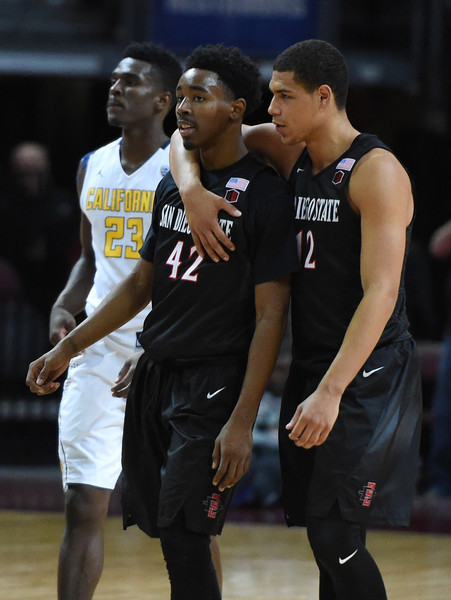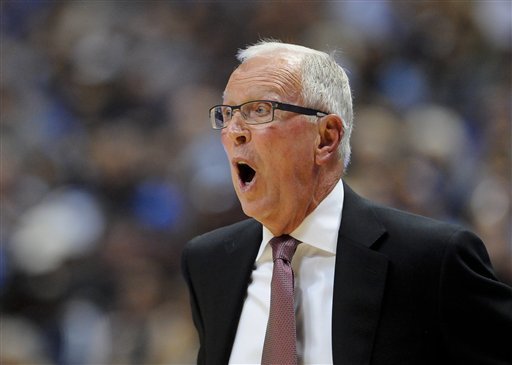San Diego State Succeeding Despite Its Inept Offense
Posted by Andrew Murawa (@Amurawa) on February 1st, 2016On Saturday evening, San Diego State completed a perfect first half of conference play by going into the Thomas & Mack Center and coming away with a comfortable 15-point win over UNLV. As usual, the Aztecs earned the win not on the basis of amazing offense, but on athletic, grinding, demoralizing defense. Steve Fisher‘s team blocked seven shots, challenged seemingly every jumper and held UNLV to a mere 0.83 points per possession. The Aztecs played slowly (34.7 percent of their possessions ended with five seconds or fewer on the shot clock), deliberate and, yes, maybe a little ugly. But none of this is new. Fisher’s heyday on Montezuma Mesa has been marked by defense-first teams, and increasingly, a slow tempo has corresponded with that. Perhaps unbelievably given how defensively-oriented his teams have been, this year’s group is more reliant on that defensive identity than any previous team in the Fisher era.
First, let’s look at the history. In each of the Aztecs’ last 10 seasons, the team has ranked higher nationally in defensive efficiency than offensive efficiency (per KenPom). Furthermore, the Aztecs have been among the top 10 defensive teams nationally four times, and their adjusted defensive efficiency has checked in below 90 points per 100 possessions three times (including this season). In seven of those 10 years, the Aztecs have played at a bottom-half tempo nationally. As a result of all these numbers, San Diego State has gone 250-85 (74.6%) overall, 113-42 (72.9%) in the Mountain West, taken six trips to the NCAA Tournament, notched the only five NCAA wins in program history while there, and earned two Sweet Sixteen appearances.
There have also been some very good offensive teams mixed in there. For example, the Kawhi Leonard Aztecs of 2011 averaged an adjusted 111.5 points per 100 possessions, good for 32nd in the nation — but even that team focused on elite defense (second nationally). What makes this year’s team so different is just how bad its offense has been. For the first time in the KenPom era, the Aztecs are averaging less than a point per possession, and there are 250 Division I teams that have more efficient offenses. For greater context, there have been only seven teams in the 15-year advanced metrics era that have allowed fewer than 90 points per 100 possessions while also being unable to top the 100 points per 100 possessions mark. West Coast basketball fans, avert your eyes.

The Seven Teams In The Past 15 Years With Defensive Ratings Below 90 and Offensive Ratings Below 100
So, why the defense is so good is the easy question to answer: Fisher preaches sound defensive principles and has long, athletic and versatile perimeter defenders (Winston Shepard, Zylan Cheatham and Trey Kell) to go along with a great rim-protector (Skylar Spencer). But why is a team with such skilled guards like Hemsley and Kell; with such elite and versatile wings like Shepard, Cheatham, Malik Pope and Dakarai Allen; and with such productive offensive-rebounding bigs like Spencer and Angelo Chol, so darn bad on offense? Let’s dig into the gory details.
First, the broad strokes: This team shoots a collective 45.5% eFG, good for 317th in the nation; they’re also 317th in the nation (30.8%) from three-point land. They turn the ball over on almost a fifth of all possessions, good for 272nd in the nation. The one thing the team does well is draw fouls and get to the free throw line (its 46.7% FT Rate is 12th-best nationally), but once they get there, they shoot just 68.3%, 226th in the nation. Digging in a bit more, the details show that this team plays to its own inefficiencies and those of the sport as a whole. The basis of modern basketball analytics is that teams should look for either high-quality shots at the rim or value-added three-pointers. Instead, the Aztecs rank 301st in the nation in its percentage of shots at the rim (30.9%) and 247th in the nation in its percentage of shots from three (31.7%). What remains is a team that takes 37.4 percent of its shots on two-point jumpers (29th in the nation), the least efficient shot in basketball. To make matters worse, nobody on the Aztecs can consistently make those shots, evidenced by ranking 336th in the nation in made two-point jumpers (30%).
Let’s dial up the microscope more and look at some of the gruesome individual details. There’s the senior Shepard, who leads the team by using a quarter of its offensive possessions. Nearly half of the shots he takes (87 of his 177 FGAs) have been two-point jumpers — he’s made just 21 of those (24.1%). Pope takes slightly fewer two-point jumpers and makes them at a slightly higher rate, while Chol, of all people, takes 58.2 percent of his shots as two-point jumpers — making just 30 percent of them. Then there are the guards, Hemsley and Kell. The pair ranks second and third on the team in usage, with Kell leading the team in percentage of shots taken. But while both are capable three-point shooters (Kell hits at a 37.8 percent clip; Hemsley at 37.1 percent), they shoot way too many two-point jumpers. And while Hemsley has the ability to get to the rim off the bounce, Kell is basically just a jump-shooter offensively. Greater criticism comes from their inability to find good looks for their teammates. Hemsley only assists on 18.5 percent of his teammates’ made field goals, a paltry number for a point guard. At this stage, he’s more of a scoring point guard, capable of getting his own shot but failing to learn the art of drawing defensive attention to set up a teammate for an open look. Combined with Kell, the two guards average nearly 60 minutes per night, fewer than four assists per game, and turn the ball over more often than delivering dimes.

Jeremy Hemsley And Trey Kell Have Been Unable To Kick The Aztecs’ Offense Into High Gear (Ethan Miller, Getty Images)
All of those numbers are gloomy enough, but there is some light at the end of the tunnel. Believe it or not, this team still has a lot of upside. While Hemsley is still finding his way as a freshman point guard, he is a really bright kid who has great potential. Unlike some of the other iterations of Aztecs, there are several guys (Hemsley, Kell, Allen, and junior wing Matt Shrigley, freshly back from ACL surgery) who are capable of knocking in threes at an acceptable rate. We know that Hemsley, Shepard and Cheatham are capable of producing off the bounce and there are no shortage of players who can create highlight-reel plays above the rim. Chol continues to flash occasional glimpses of coherent post moves. While this team isn’t going to turn into an offensive juggernaut in the next six weeks, it still has an opportunity for significant improvement on the offensive end. For example, San Diego State has scored better than a point per possession in seven of its nine Mountain West games, but Fisher needs to do a better job encouraging and executing with greater efficiency. Continuing to rely on two-point jumpers to the exclusion of shots that provide a higher return is not sustainable; a substantial strategic tweak is in order.
While Hemsley has been the starting point guard since day one this season, it’s now time for Fisher to completely turn over the reins to his freshman. He’s the most complete offensive player on the team and a guy that can score from all ranges. He needs to work on getting his teammates more involved, of course, but even if that doesn’t happen right away, the Aztecs are better off with the ball in his hands. Next, Cheatham needs a more prominent offensive role even if that means usurping some of the touches that Shepard has earned over his four seasons. The long freshman is very aggressive going to the hoop and is the one player on this team who has a demonstrated ability to finish at the rim (72.6%). What’s more, he’s capable of producing those shots on his own, whether via offensive rebound putbacks, transition opportunities or off the bounce. By shifting more of the offensive load to Hemsley and Cheatham, Fisher would not only be putting the ball in the hands of his most efficient offensive players, but he would also be setting those youngsters up with experience they’ll need to build their Aztecs careers.
For a team that isn’t suddenly going to become elite offensively, this group cannot rely so unilaterally on its defense. In order to maximize this year’s potential, San Diego State needs to inch its way to a marginally better offense.











































